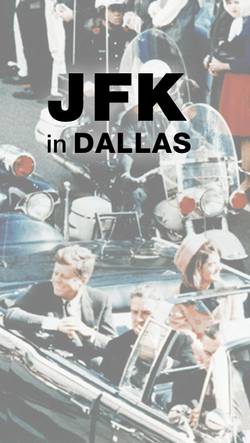 Fifty Years After JFK Assassination, Dallas Site of Oswald's Murder Remains in Shadows As World Observes 50th, Important Landmarks Remain Closed to Public DALLAS - This city's old downtown police headquarters was rundown even in 1963, a dull-gray Frankenstein of a building that married a five-story neo-classic structure with a drab 1950s-era annex. I know the place well, having worked long hours inside a closet-sized, windowless office on the building's third floor as a crime writer for the Dallas Morning News in the early 2000s, often coming and going in the mostly deserted building well past midnight. As workers place the finishing cosmetic touches on the Grassy Knoll, Dealey Plaza and the sixth-floor sniper's perch inside the Texas School Book Depository in advance of the 50th anniversary of President Kennedy's assassination on a downtown Dallas street, surprisingly little is being done to direct observers to the old police building and its important place in this terrible story. About 18 blocks from Dealey Plaza on the east side of downtown, piles of discarded bricks fill a stairwell outside the building, and a nondescript plaque tarnished with decades' worth of pigeon droppings offers only a vague and understated account that this is the building where Jack Ruby fatally shot Lee Harvey Oswald. The building may be recognized on Texas' historical register, but access to these important sites is shuttered to the public. The police department moved to a state-of-the-art facility 10 years ago, and most Dallas residents know the building today as the place to take care of traffic tickets. Plans call for the city to entirely vacate the building one day and turn it over to the University of North Texas to become part of its new downtown law school. The disregard for this historic spot and others around Dallas as the anniversary approaches is unfortunate because what transpired inside two days after the assassination propelled an already horrendous story into uncharted territory. If there needed to be a historical marker for all the doubt cast about the official investigation and the plain bizarre twists of this story, it would arguably be here at 2014 Main St. Had Oswald walked out of this building alive and faced trial, there would be no doubt today. This is where Oswald spent his last 48 hours, thanks to a shocking mishandling of security by Dallas police. The result: The prime suspect in arguably the crime of the century - the only legitimate suspect to ever emerge in the last five decades - was allowed to be murdered on live TV by an emotionally unstable, mob-connected burlesque joint impresario. Witnessed by more than 20 million Americans watching in their living rooms on a Sunday morning two days after the assassination, Oswald's death solidified countless conspiracies and served as an anchor for the city's plummeting reputation. Swirling rumors pushed President Johnson to impanel the Warren Commission, and despite that exhaustive probe and the best efforts from additional official investigations in later decades, those who don't want to believe that Oswald acted alone can point to his death as proof. Remarkable police work resulted in Oswald's arrest inside the Texas Theatre during a Friday matinee of "War is Hell." Within two hours of the president's death, he was taken to the third-floor homicide offices, and a growing mob of news reporters followed. By all accounts, it was a surreal scene. An FBI agent described a circus-like atmosphere as "not too much unlike Grand Central Station at rush hour, maybe like the Yankee Stadium during the World Series games." Day and night, reporters and the public had free run of the place and shouted questions at Oswald whenever he was moved down the hallways. Dallas Police Chief Jesse Curry called it "pandemonium on the third floor... a bedlam of confusion." Girlie-club owner Jack Ruby was there, too, hopped up on Preludin diet pills and increasingly distraught about the president's death. Ruby's Carousel Club was just a few blocks down on Commerce Street, and he came and went throughout those 48 hours, bringing sandwiches for the cops and reporters and attending the press briefings. That Sunday morning, Ruby drove downtown with a handgun, $2,000 cash and his dachshund, Sheba. Apparently in no hurry, he first visited a Western Union office and wired $25 to one of his down-and-out dancers. He then walked a few hundred feet down the sidewalk and slipped unnoticed down the ramp into the basement parking lot, joining a scrum of reporters and officers awaiting Oswald's move. The black-and-white film footage gives the scene an unreal quality. Everyone's in dark suits and ties with fedoras as the officers and Oswald part the crowd. Suddenly, Ruby steps forward with gun in hand and fires a single gunshot into Oswald's abdomen before pandemonium breaks out. Dallas struggles to this day with the suggestion that its highly charged conservative political climate was somehow responsible for President Kennedy's death. A city to blame for the actions of a single crackpot? Of course not. But this much is certain, the city had a responsibility to protect the only known suspect, and the shockingly lax security inside the Dallas police station can be blamed for Oswald's death. And with Oswald silenced in death, the city's reputation was sealed. As Dallas seeks to put its best image forward and mark the anniversary with a solemn and respectful observance at the well-manicured Dealey Plaza, it's important that the city take ownership of the entire story and preserve important pieces of this vanishing history. Dallas resident Robert Tharp is the co-creator of the new JFK in Dallas 50 app, providing an interactive guide to the assassination of President Kennedy and a virtual tour of the vanishing historic sites in Dallas. Find it on iTunes: https://itunes.apple.com/app/jfk-in-dallas-50/id694762432?mt=8
0 Comments
Leave a Reply. |
AuthorWrite something about yourself. No need to be fancy, just an overview. ArchivesCategories
All
|
 RSS Feed
RSS Feed
